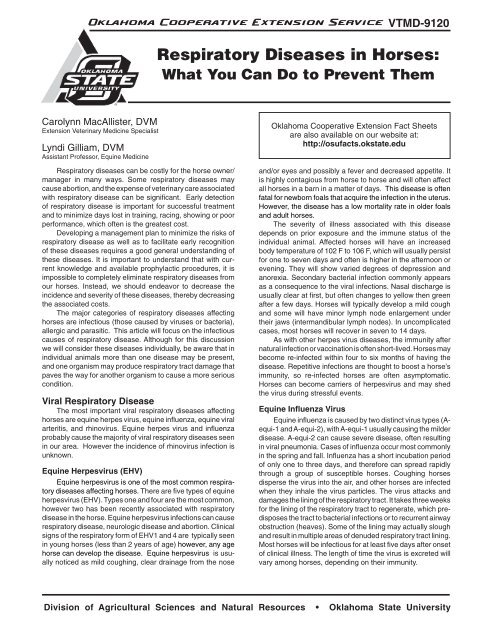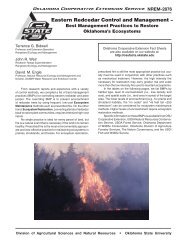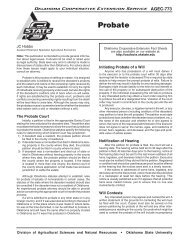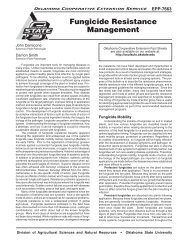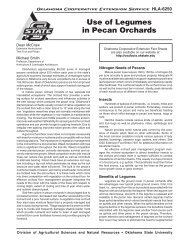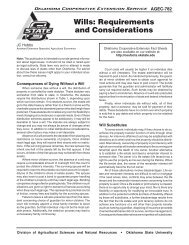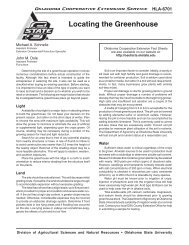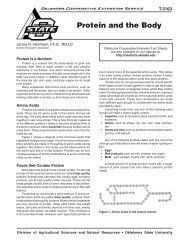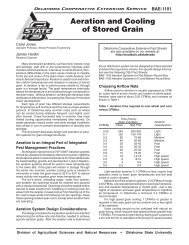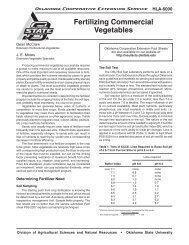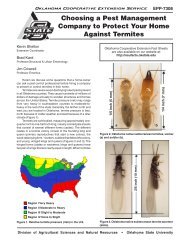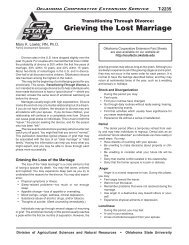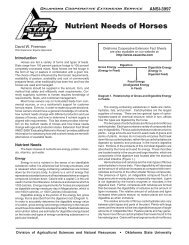Respiratory Diseases in Horses: - OSU Fact Sheets - Oklahoma ...
Respiratory Diseases in Horses: - OSU Fact Sheets - Oklahoma ...
Respiratory Diseases in Horses: - OSU Fact Sheets - Oklahoma ...
Create successful ePaper yourself
Turn your PDF publications into a flip-book with our unique Google optimized e-Paper software.
<strong>Oklahoma</strong> Cooperative Extension Service<br />
VTMD-9120<br />
<strong>Respiratory</strong> <strong>Diseases</strong> <strong>in</strong> <strong>Horses</strong>:<br />
What You Can Do to Prevent Them<br />
Carolynn MacAllister, DVM<br />
Extension Veter<strong>in</strong>ary Medic<strong>in</strong>e Specialist<br />
Lyndi Gilliam, DVM<br />
Assistant Professor, Equ<strong>in</strong>e Medic<strong>in</strong>e<br />
<strong>Respiratory</strong> diseases can be costly for the horse owner/<br />
manager <strong>in</strong> many ways. Some respiratory diseases may<br />
cause abortion, and the expense of veter<strong>in</strong>ary care associated<br />
with respiratory disease can be significant. Early detection<br />
of respiratory disease is important for successful treatment<br />
and to m<strong>in</strong>imize days lost <strong>in</strong> tra<strong>in</strong><strong>in</strong>g, rac<strong>in</strong>g, show<strong>in</strong>g or poor<br />
performance, which often is the greatest cost.<br />
Develop<strong>in</strong>g a management plan to m<strong>in</strong>imize the risks of<br />
respiratory disease as well as to facilitate early recognition<br />
of these diseases requires a good general understand<strong>in</strong>g of<br />
these diseases. It is important to understand that with current<br />
knowledge and available prophylactic procedures, it is<br />
impossible to completely elim<strong>in</strong>ate respiratory diseases from<br />
our horses. Instead, we should endeavor to decrease the<br />
<strong>in</strong>cidence and severity of these diseases, thereby decreas<strong>in</strong>g<br />
the associated costs.<br />
The major categories of respiratory diseases affect<strong>in</strong>g<br />
horses are <strong>in</strong>fectious (those caused by viruses or bacteria),<br />
allergic and parasitic. This article will focus on the <strong>in</strong>fectious<br />
causes of respiratory disease. Although for this discussion<br />
we will consider these diseases <strong>in</strong>dividually, be aware that <strong>in</strong><br />
<strong>in</strong>dividual animals more than one disease may be present,<br />
and one organism may produce respiratory tract damage that<br />
paves the way for another organism to cause a more serious<br />
condition.<br />
Viral <strong>Respiratory</strong> Disease<br />
The most important viral respiratory diseases affect<strong>in</strong>g<br />
horses are equ<strong>in</strong>e herpes virus, equ<strong>in</strong>e <strong>in</strong>fluenza, equ<strong>in</strong>e viral<br />
arteritis, and rh<strong>in</strong>ovirus. Equ<strong>in</strong>e herpes virus and <strong>in</strong>fluenza<br />
probably cause the majority of viral respiratory diseases seen<br />
<strong>in</strong> our area. However the <strong>in</strong>cidence of rh<strong>in</strong>ovirus <strong>in</strong>fection is<br />
unknown.<br />
Equ<strong>in</strong>e Herpesvirus (EHV)<br />
Equ<strong>in</strong>e herpesvirus is one of the most common respiratory<br />
diseases affect<strong>in</strong>g horses. There are five types of equ<strong>in</strong>e<br />
herpesvirus (EHV). Types one and four are the most common,<br />
however two has been recently associated with respiratory<br />
disease <strong>in</strong> the horse. Equ<strong>in</strong>e herpesvirus <strong>in</strong>fections can cause<br />
respiratory disease, neurologic disease and abortion. Cl<strong>in</strong>ical<br />
signs of the respiratory form of EHV1 and 4 are typically seen<br />
<strong>in</strong> young horses (less than 2 years of age) however, any age<br />
horse can develop the disease. Equ<strong>in</strong>e herpesvirus is usually<br />
noticed as mild cough<strong>in</strong>g, clear dra<strong>in</strong>age from the nose<br />
<strong>Oklahoma</strong> Cooperative Extension <strong>Fact</strong> <strong>Sheets</strong><br />
are also available on our website at:<br />
http://osufacts.okstate.edu<br />
and/or eyes and possibly a fever and decreased appetite. It<br />
is highly contagious from horse to horse and will often affect<br />
all horses <strong>in</strong> a barn <strong>in</strong> a matter of days. This disease is often<br />
fatal for newborn foals that acquire the <strong>in</strong>fection <strong>in</strong> the uterus.<br />
However, the disease has a low mortality rate <strong>in</strong> older foals<br />
and adult horses.<br />
The severity of illness associated with this disease<br />
depends on prior exposure and the immune status of the<br />
<strong>in</strong>dividual animal. Affected horses will have an <strong>in</strong>creased<br />
body temperature of 102 F to 106 F, which will usually persist<br />
for one to seven days and often is higher <strong>in</strong> the afternoon or<br />
even<strong>in</strong>g. They will show varied degrees of depression and<br />
anorexia. Secondary bacterial <strong>in</strong>fection commonly appears<br />
as a consequence to the viral <strong>in</strong>fections. Nasal discharge is<br />
usually clear at first, but often changes to yellow then green<br />
after a few days. <strong>Horses</strong> will typically develop a mild cough<br />
and some will have m<strong>in</strong>or lymph node enlargement under<br />
their jaws (<strong>in</strong>termandibular lymph nodes). In uncomplicated<br />
cases, most horses will recover <strong>in</strong> seven to 14 days.<br />
As with other herpes virus diseases, the immunity after<br />
natural <strong>in</strong>fection or vacc<strong>in</strong>ation is often short-lived. <strong>Horses</strong> may<br />
become re-<strong>in</strong>fected with<strong>in</strong> four to six months of hav<strong>in</strong>g the<br />
disease. Repetitive <strong>in</strong>fections are thought to boost a horse’s<br />
immunity, so re-<strong>in</strong>fected horses are often asymptomatic.<br />
<strong>Horses</strong> can become carriers of herpesvirus and may shed<br />
the virus dur<strong>in</strong>g stressful events.<br />
Equ<strong>in</strong>e Influenza Virus<br />
Equ<strong>in</strong>e <strong>in</strong>fluenza is caused by two dist<strong>in</strong>ct virus types (Aequi-1<br />
and A-equi-2), with A-equi-1 usually caus<strong>in</strong>g the milder<br />
disease. A-equi-2 can cause severe disease, often result<strong>in</strong>g<br />
<strong>in</strong> viral pneumonia. Cases of <strong>in</strong>fluenza occur most commonly<br />
<strong>in</strong> the spr<strong>in</strong>g and fall. Influenza has a short <strong>in</strong>cubation period<br />
of only one to three days, and therefore can spread rapidly<br />
through a group of susceptible horses. Cough<strong>in</strong>g horses<br />
disperse the virus <strong>in</strong>to the air, and other horses are <strong>in</strong>fected<br />
when they <strong>in</strong>hale the virus particles. The virus attacks and<br />
damages the l<strong>in</strong><strong>in</strong>g of the respiratory tract. It takes three weeks<br />
for the l<strong>in</strong><strong>in</strong>g of the respiratory tract to regenerate, which predisposes<br />
the tract to bacterial <strong>in</strong>fections or to recurrent airway<br />
obstruction (heaves). Some of the l<strong>in</strong><strong>in</strong>g may actually slough<br />
and result <strong>in</strong> multiple areas of denuded respiratory tract l<strong>in</strong><strong>in</strong>g.<br />
Most horses will be <strong>in</strong>fectious for at least five days after onset<br />
of cl<strong>in</strong>ical illness. The length of time the virus is excreted will<br />
vary among horses, depend<strong>in</strong>g on their immunity.<br />
Division of Agricultural Sciences and Natural Resources • <strong>Oklahoma</strong> State University
The cl<strong>in</strong>ical signs seen with <strong>in</strong>fluenza are similar to those<br />
associated with other viral respiratory diseases. Fever is<br />
usually present and ranges from 103 F to106 F. <strong>Horses</strong> have<br />
varied degrees of depression and anorexia. In uncomplicated<br />
<strong>in</strong>fluenza cases, most cl<strong>in</strong>ical signs last from two to 10 days,<br />
but affected horses often develop a dry, nonproductive cough<br />
that can last two to three weeks or longer. The nasal discharge<br />
is usually clear at first, but usually becomes thick and<br />
pus-like. Intermandibular lymph nodes may become slightly<br />
enlarged, and some horses appear to have muscle soreness.<br />
<strong>Horses</strong> with A-equi-2 will show the most severe signs. These<br />
horses will often have high respiratory rates, and some will<br />
have difficulty breath<strong>in</strong>g. The severe cl<strong>in</strong>ical signs seen with<br />
A-equi-2 will often be present for seven to 10 days. <strong>Horses</strong><br />
can develop a generalized vasculitis, which is manifested as<br />
swell<strong>in</strong>g of the limbs, <strong>in</strong>flammation of the heart result<strong>in</strong>g <strong>in</strong> a<br />
high heart rate and <strong>in</strong>flammation of the eye result<strong>in</strong>g <strong>in</strong> tear<strong>in</strong>g<br />
and squ<strong>in</strong>t<strong>in</strong>g of the eye. Immunity to equ<strong>in</strong>e <strong>in</strong>fluenza<br />
will last approximately one year after natural <strong>in</strong>fection,two to<br />
three months after <strong>in</strong>tramuscular vacc<strong>in</strong>ation, and 6 months<br />
after <strong>in</strong>tra-nasal vacc<strong>in</strong>ation.<br />
Equ<strong>in</strong>e Viral Arteritis (EVA)<br />
Equ<strong>in</strong>e viral arteritis is a viral disease of horses that can<br />
cause respiratory disease and abortions. Even though the<br />
virus has a worldwide distribution, <strong>in</strong>cidence of the disease<br />
is uncommon but have occurred <strong>in</strong> <strong>Oklahoma</strong>. EVA has an<br />
<strong>in</strong>cubation period longer than the other viral respiratory diseases,<br />
rang<strong>in</strong>g from three to 14 days. The virus is shed <strong>in</strong><br />
nasal secretions. Stallions affected with EVA may shed the<br />
virus <strong>in</strong> their semen for years and are capable of transmitt<strong>in</strong>g<br />
the disease to mares. As with other viral respiratory <strong>in</strong>fections,<br />
EVA is acquired by <strong>in</strong>halation of the virus, exposure to viruscontam<strong>in</strong>ated<br />
objects or environment.<br />
The cl<strong>in</strong>ical signs associated with EVA <strong>in</strong>fection are similar<br />
to other viral respiratory diseases, but can vary from severe<br />
to subcl<strong>in</strong>ical. However, this disease should be suspected if<br />
the follow<strong>in</strong>g are present:<br />
• more discharge from the eyes than usually seen with<br />
other respiratory diseases<br />
• red and <strong>in</strong>flamed l<strong>in</strong><strong>in</strong>g <strong>in</strong> the nasal passages<br />
• swell<strong>in</strong>g <strong>in</strong> the limbs and ventral abdomen<br />
• abortions dur<strong>in</strong>g or with<strong>in</strong> a few days of the illness<br />
EVA is a viral disease that is reportable to the state veter<strong>in</strong>arian’s<br />
office.<br />
Treatment of Viral <strong>Respiratory</strong> <strong>Diseases</strong><br />
Viral respiratory diseases can mimic more serious respiratory<br />
diseases. The attend<strong>in</strong>g veter<strong>in</strong>arian should exam<strong>in</strong>e<br />
affected horses to determ<strong>in</strong>e the seriousness of the illness.<br />
Only the symptoms are treated, rather than the cause, with<br />
the most important component of therapy for uncomplicated<br />
viral respiratory diseases be<strong>in</strong>g rest. Stress should be kept<br />
to a m<strong>in</strong>imum. If possible, the horse should not be hauled<br />
long distances, and forced exercise of any k<strong>in</strong>d should be<br />
discont<strong>in</strong>ued. Affected horses should be housed <strong>in</strong> an area<br />
with good ventilation, and dust should be kept to a m<strong>in</strong>imum.<br />
Unless the weather is <strong>in</strong>clement, outside <strong>in</strong> the sunsh<strong>in</strong>e and<br />
fresh air may be the best environment for recovery.<br />
It is important to remember that antibiotics are not effective<br />
aga<strong>in</strong>st viruses. However, for the horse with severe viral<br />
respiratory disease or one that is stressed for another reason,<br />
appropriate antibiotics may be adm<strong>in</strong>istered prophylactically<br />
to decrease the chances of an opportunistic bacteria caus<strong>in</strong>g<br />
a more severe disease. It is also important to remember that<br />
it can take a prolonged period of time for the respiratory tract<br />
to heal from a viral <strong>in</strong>fection. The typical recommendation<br />
for rest of the respiratory system after a viral <strong>in</strong>fection is one<br />
week of rest for every day of fever.<br />
Complications of Viral <strong>Respiratory</strong> <strong>Diseases</strong><br />
Uncomplicated viral respiratory diseases are usually selflimit<strong>in</strong>g,<br />
and the affected horses recover with no long-last<strong>in</strong>g<br />
ill effects. However, horses with viral respiratory diseases<br />
that are also stressed by shipp<strong>in</strong>g, tra<strong>in</strong><strong>in</strong>g, rac<strong>in</strong>g, surgery,<br />
etc. may develop severe and sometimes fatal pneumonia.<br />
Frequent exam<strong>in</strong>ation of the affected horse’s respiratory<br />
tract is <strong>in</strong>dicated to monitor for secondary complications like<br />
pneumonia, pleuropneumonia and myocarditis (<strong>in</strong>flammation<br />
of the heart). There is also some <strong>in</strong>dication that viral respiratory<br />
disease may predispose a horse to chronic obstructive<br />
pulmonary disease (heaves) and exercise-<strong>in</strong>duced pulmonary<br />
hemorrhage (bleeders).<br />
Bacterial <strong>Respiratory</strong> Disease<br />
Many bacteria are capable of caus<strong>in</strong>g respiratory disease<br />
<strong>in</strong> horses. Some bacteria only cause disease when viruses or<br />
other agents have first damaged the respiratory tract. Other<br />
bacteria are capable of produc<strong>in</strong>g disease <strong>in</strong>dependently. For<br />
this discussion, we will consider the two most important bacterial<br />
diseases for <strong>Oklahoma</strong> horses: Strangles and Rhodoccus<br />
equi.<br />
Strangles<br />
Strangles is a bacterial disease caused by Streptococcus<br />
equi. It is most commonly seen <strong>in</strong> one- to five-year-old horses.<br />
However, any age susceptible horses can get the disease,<br />
and older horses that have wan<strong>in</strong>g immunity may develop the<br />
disease even if they had it at a younger age. There is usually<br />
a two- to six-day <strong>in</strong>cubation period, and 30 to 100 percent of<br />
the horses on the farm may develop the disease. <strong>Horses</strong> affected<br />
with this disease have a copious thick white to yellow<br />
nasal discharge that conta<strong>in</strong>s high numbers of the bacteria.<br />
They contam<strong>in</strong>ate the environment, <strong>in</strong>clud<strong>in</strong>g feed tubs,<br />
water buckets and walls with the bacteria. Anyth<strong>in</strong>g <strong>in</strong> the<br />
horses’ environment contam<strong>in</strong>ated with the bacteria (such<br />
as handlers’ boots and clothes, flies, brushes or halters) can<br />
be a source of <strong>in</strong>fection for other horses. <strong>Horses</strong> acquire the<br />
disease by direct contact with the bacteria either by <strong>in</strong>halation<br />
or <strong>in</strong>gestion. The bacteria itself may survive <strong>in</strong> the environment<br />
for a few weeks. This disease is difficult to eradicate<br />
because some horses shed the bacteria for long periods.<br />
Affected horses will typically shed the bacteria for at least<br />
four to six weeks. One survey reported that one mare shed<br />
the bacteria for ten months, and long-term carriers may be<br />
more common than previously thought. Natural immunity to<br />
the disease after <strong>in</strong>fection is usually long-last<strong>in</strong>g. However,<br />
some <strong>in</strong>dividuals may acquire the disease more than once.<br />
Cl<strong>in</strong>ical signs associated with strangles <strong>in</strong>clude fever (103<br />
F to 106 F), serous nasal dra<strong>in</strong>age evolv<strong>in</strong>g to a thick, yellow<br />
to white and copious discharge, moist cough, difficulty swallow<strong>in</strong>g,<br />
depression and decreased or nonexistent appetite.<br />
VTMD-9120-2
Lymph node swell<strong>in</strong>g between the mandibles and <strong>in</strong> the throat<br />
latch area is usually present. The lymph node swell<strong>in</strong>g with<br />
strangles is frequently severe and results <strong>in</strong> abscesses that<br />
often rupture and dra<strong>in</strong> pus.<br />
Strangles can have a high <strong>in</strong>cidence (up to 10 percent)<br />
of complications. Complications <strong>in</strong>clude becom<strong>in</strong>g a chronic<br />
carrier of the disease, asphyxia due to enlarged lymph nodes<br />
compress<strong>in</strong>g the larynx or w<strong>in</strong>dpipe, bastard strangles (spread<strong>in</strong>g<br />
to other areas of the body), pneumonia, guttural pouches<br />
filled with pus, purpura hemorrhagica and heart disease.<br />
<strong>Horses</strong> may also develop severe muscle wast<strong>in</strong>g secondary<br />
to strangles. The average length for the course of this disease<br />
is 23 days.<br />
Rhodococcus equi Pneumonia<br />
Rhodococcus equi pneumonia is a sporadic disease that<br />
usually occurs <strong>in</strong> one- to six-month-old foals. It is endemic on<br />
some farms, and the disease will appear <strong>in</strong> one to 10 percent<br />
of each foal crop. Most <strong>in</strong>fections will be <strong>in</strong> foals two to three<br />
months of age, which is when maternal antibody concentration<br />
is wan<strong>in</strong>g. Foals can be <strong>in</strong>fected at birth, but will not show<br />
signs of illness until one to six months of age. The organism is<br />
commonly found <strong>in</strong> the soil and can often be cultured from the<br />
feces of dams that had affected foals and of normal horses.<br />
Foals probably become <strong>in</strong>fected by <strong>in</strong>halation of the bacteria<br />
from the soil. The disease does not appear to be transmitted<br />
by direct contact between horses.<br />
One of the major problems <strong>in</strong> deal<strong>in</strong>g with Rhodococcus<br />
pneumonia is it has an <strong>in</strong>sidious onset. Foals usually start<br />
with a low-grade fever, but may have temperatures up to 106<br />
F. They may or may not cough <strong>in</strong> the <strong>in</strong>itial stages of the disease.<br />
Often there is no abnormal nasal discharge early <strong>in</strong> the<br />
disease process. As the disease progresses, the foals become<br />
depressed, nurs<strong>in</strong>g is dim<strong>in</strong>ished, difficult breath<strong>in</strong>g becomes<br />
apparent, and weight loss or failure to grow may be evident. In<br />
addition to respiratory disease, Rhodococcus equi can cause<br />
diarrhea, septic and nonseptic synovitis (jo<strong>in</strong>t <strong>in</strong>flammation),<br />
bone <strong>in</strong>fection and <strong>in</strong>tra-abdom<strong>in</strong>al abscessation.<br />
The fundamental components of Rhodococcus pneumonia<br />
treatment are early detection, rapid and accurate diagnosis<br />
and specific antibiotic therapy. It is often necessary to cont<strong>in</strong>ue<br />
the antibiotic therapy for several weeks.<br />
Control of Rhodococcus equi pneumonia is very difficult<br />
even with current knowledge and available products. No commercial<br />
vacc<strong>in</strong>e is available. Prophylactic hyperimmune serum<br />
adm<strong>in</strong>istered <strong>in</strong>travenously has been reported to be effective.<br />
Other prophylactic protocols have been published and may<br />
be worth discuss<strong>in</strong>g with your veter<strong>in</strong>arian. S<strong>in</strong>ce it is thought<br />
the natural disease is acquired by <strong>in</strong>halation and we know the<br />
bacteria are <strong>in</strong> the soil, it may be beneficial to reduce dust and<br />
properly ventilate hous<strong>in</strong>g. As with all respiratory diseases,<br />
reduce stress by not overcrowd<strong>in</strong>g and by keep<strong>in</strong>g the handl<strong>in</strong>g<br />
of foals to a m<strong>in</strong>imum. Frequent removal of manure will help<br />
m<strong>in</strong>imize environmental contam<strong>in</strong>ation and may reduce the<br />
<strong>in</strong>cidence of <strong>in</strong>fection. It is also important to verify that the foal<br />
has had proper colostral <strong>in</strong>take shortly after birth.<br />
<strong>Respiratory</strong> <strong>Diseases</strong> Caused by Internal<br />
Parasites<br />
Two equ<strong>in</strong>e <strong>in</strong>ternal parasites migrate through the lungs<br />
as a portion of their life cycle. The equ<strong>in</strong>e roundworm is one<br />
of the most common <strong>in</strong>ternal parasites of young horses. It is<br />
probably present <strong>in</strong> every horse operation <strong>in</strong> <strong>Oklahoma</strong>. After<br />
this parasite is <strong>in</strong>gested by the horse, it then migrates from the<br />
<strong>in</strong>test<strong>in</strong>e to the liver and then to the lung, where it is coughed<br />
up and swallowed to become an adult <strong>in</strong> the <strong>in</strong>test<strong>in</strong>e. Foals<br />
given large numbers of the parasite experimentally develop a<br />
cough and nasal discharge similar to other respiratory diseases.<br />
In uncomplicated cases, the horse’s temperature rema<strong>in</strong>s near<br />
normal. It is unknown if under natural conditions this parasite<br />
causes cl<strong>in</strong>ically detectable respiratory disease. However, it is<br />
quite possible the damage caused by this parasite predisposes<br />
young horses to other respiratory diseases. For this reason, a<br />
good deworm<strong>in</strong>g program is recommended for all foals. Most<br />
horses develop a resistance to roundworms by two to three<br />
years of age.<br />
The equ<strong>in</strong>e lungworm, even though not commonly seen<br />
<strong>in</strong> <strong>Oklahoma</strong>, can cause chronic cough<strong>in</strong>g <strong>in</strong> affected horses.<br />
<strong>Horses</strong> are not the favorite host of this parasite and do not<br />
usually transmit the disease to other horses. In most <strong>in</strong>stances,<br />
horses acquire this disease when pastured with donkeys.<br />
Prevention Program to Control<br />
<strong>Respiratory</strong> <strong>Diseases</strong><br />
Each horse owner, <strong>in</strong> consultation with their attend<strong>in</strong>g<br />
veter<strong>in</strong>arian, should develop a written vacc<strong>in</strong>ation program<br />
appropriate for their situation. Accurate vacc<strong>in</strong>ation records<br />
should then be ma<strong>in</strong>ta<strong>in</strong>ed on all horses. All horses <strong>in</strong> <strong>Oklahoma</strong><br />
should be vacc<strong>in</strong>ated <strong>in</strong> the spr<strong>in</strong>g for eastern and western<br />
encephalomyelitis, tetanus and West Nile Virus (WNV). Additional<br />
vacc<strong>in</strong>ations may be recommended for your horses to<br />
prevent respiratory diseases. A local veter<strong>in</strong>arian can prescribe<br />
the best vacc<strong>in</strong>ation program for your particular situation.<br />
Although vacc<strong>in</strong>ation programs may vary accord<strong>in</strong>g to the<br />
environment <strong>in</strong> which horses live, for specific <strong>in</strong>formation on the<br />
above viruses and bacteria and to consider when develop<strong>in</strong>g a<br />
vacc<strong>in</strong>ation program for your horse, please consult the Equ<strong>in</strong>e<br />
Vacc<strong>in</strong>ation Programs VTMD-9119. <strong>Horses</strong>, once vacc<strong>in</strong>ated<br />
with an effective vacc<strong>in</strong>e and then revacc<strong>in</strong>ated, have what is<br />
termed an anamnestic response. This response is very rapid (just<br />
a few days) and produces high levels of protective antibodies.<br />
With some plann<strong>in</strong>g, the anamnestic response can be utilized<br />
to protect horses that will subsequently be stressed or exposed<br />
to respiratory diseases. For this reason, horses participat<strong>in</strong>g<br />
<strong>in</strong> sales, shows, racetracks, etc. can be better protected by a<br />
booster vacc<strong>in</strong>ation two to four weeks prior to the event.<br />
The newborn foal obta<strong>in</strong>s protection from respiratory<br />
diseases from their dams’ colostrum. This colostral protection<br />
provides passive immunity. Colostral protection or passive<br />
immunity lasts a varied amount of time, which is related to<br />
the amount of protective antibodies <strong>in</strong> the colostrum and how<br />
fast the antibodies are used up by the foal. To further boost<br />
the passive immunity of the colostral transfer to the foal, it is<br />
also advantageous to keep the mare at the facility where she<br />
is to foal at least six to eight weeks prior to foal<strong>in</strong>g.<br />
Colostral antibodies aga<strong>in</strong>st some diseases last longer<br />
than others. In general, the protective levels of antibodies<br />
acquired from the dam are too low to be protective by two to<br />
three months of age. But if you vacc<strong>in</strong>ate a foal at this age,<br />
a problem arises because the residual maternal antibodies<br />
will cause the foal’s immune system to be unresponsive to<br />
vacc<strong>in</strong>ations. This effect can last for weeks or months.<br />
VTMD-9120-3
Vacc<strong>in</strong>ation is not a substitute for good management<br />
practices. <strong>Respiratory</strong> <strong>in</strong>fections spread through groups of<br />
horses by direct contact between animals, handlers and<br />
contam<strong>in</strong>ated surfaces or through <strong>in</strong>halation. A producer can<br />
m<strong>in</strong>imize the spread of <strong>in</strong>fectious organisms by quarant<strong>in</strong><strong>in</strong>g<br />
all animals brought onto the farm, especially those return<strong>in</strong>g<br />
from events such as shows, racetracks or sales. It may be<br />
necessary to quarant<strong>in</strong>e these animals for up to four weeks<br />
before they are allowed to comm<strong>in</strong>gle with resident horses. If<br />
possible, pregnant mares should be kept <strong>in</strong> a group away from<br />
other horses, especially weanl<strong>in</strong>gs and yearl<strong>in</strong>gs. When cases<br />
of respiratory disease or abortion occur, all affected horses<br />
should be isolated and not allowed to comm<strong>in</strong>gle or leave the<br />
premises until three weeks after recovery. Handlers car<strong>in</strong>g for<br />
the sick horses should limit their contact with healthy horses,<br />
and stalls, trailers. Equipment that has come <strong>in</strong> contact with<br />
sick horses should be dis<strong>in</strong>fected with products conta<strong>in</strong><strong>in</strong>g<br />
phenols, chloride or quaternary ammonium. It is also best<br />
for healthy horses to be housed <strong>in</strong> a separate airspace from<br />
sick horses.<br />
Consult your veter<strong>in</strong>arian concern<strong>in</strong>g vacc<strong>in</strong>ation protocols.<br />
A veter<strong>in</strong>arian can evaluate each horse as an <strong>in</strong>dividual,<br />
consider<strong>in</strong>g age, health and environment, to recommend<br />
vacc<strong>in</strong>ation and management programs that will provide<br />
maximum protection for each horse.<br />
<strong>Oklahoma</strong> State University, <strong>in</strong> compliance with Title VI and VII of the Civil Rights Act of 1964, Executive Order 11246 as amended, Title IX of the Education Amendments of 1972, Americans<br />
with Disabilities Act of 1990, and other federal laws and regulations, does not discrim<strong>in</strong>ate on the basis of race, color, national orig<strong>in</strong>, gender, age, religion, disability, or status as a veteran <strong>in</strong><br />
any of its policies, practices, or procedures. This <strong>in</strong>cludes but is not limited to admissions, employment, f<strong>in</strong>ancial aid, and educational services.<br />
Issued <strong>in</strong> furtherance of Cooperative Extension work, acts of May 8 and June 30, 1914, <strong>in</strong> cooperation with the U.S. Department of Agriculture, Robert E. Whitson, Director of Cooperative Extension<br />
Service, <strong>Oklahoma</strong> State University, Stillwater, <strong>Oklahoma</strong>. This publication is pr<strong>in</strong>ted and issued by <strong>Oklahoma</strong> State University as authorized by the Vice President, Dean, and Director of<br />
the Division of Agricultural Sciences and Natural Resources and has been prepared and distributed at a cost of 20 cents per copy. 0410 GH.<br />
VTMD-9120-4


